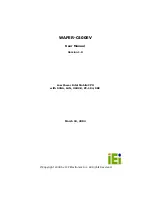
© Confidential
Page: 59 / 97
This document is the sole and exclusive property of WAVECOM. Not to be distributed or divulged without prior
written agreement.
WM_PRJ_Q2686_PTS_001-010
June 30, 2009
Q2686 Wireless CPU
®
POWER SUPPLY
ON/OFF
STATE OF THE
Wireless CPU
®
Wireless CPU
®
OFF
I
BB+RF
< 22
μ
A
AT answers « OK »
Wireless CPU
®
READY
T
on/off-hold
(2000ms min)
SIM and Network dependent
RESET mode
I
BB+RF
=20 to 40mA
INTERNAL RST
T
rst
(40ms typ)
Wireless CPU
®
ON
I
BB+RF
<120mA
I
BB+RF
= overall current consumption (Base Band + RF part)
Figure 9: Power-ON sequence (no PIN code activated)
The duration of the firmware power-up sequence depends on:
•
the need to perform a recovery sequence if the power has been lost
during a flash memory modification.
Other factors have a minor influence
•
the number of parameters stored in EEPROM by the AT commands
received so far
•
the ageing of the hardware components, especially the flash memory
•
the temperature conditions
The
recommended way to de-assert the ON/~OFF signal is to use either an AT
command or WIND indicators: the application must detect the end of the
power-up initialization and de-assert ON/~OFF afterwards.
•
Send an “AT” command and wait for the “OK” answer: once the
initialization is complete the AT interface answers « OK » to “AT” message
1
.
•
Wait for the “+WIND: 3” message: after initialization, the Wireless CPU
®
, if
configured to do so, will return an unsolicited “+WIND: 3” message. The
generation of this message is enabled or disabled via an AT command.
Note:
See also “AT Commands User Guide” [7] for more information on these
commands.
1
If the application manages hardware flow control, the AT command can be sent during the
initialisation phase.
















































